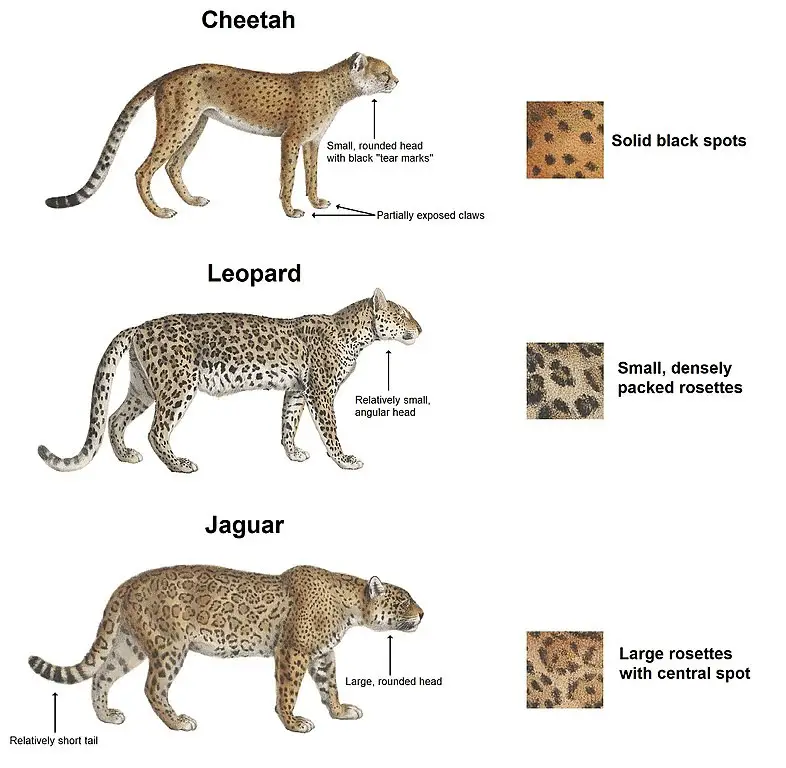The Jaguar is the largest cat in South America. It once roamed from the southern tip of South America to the US – Mexico border in the north. Now they are found in the Amazon Basin in South and Central America. Jaguars were very prominent in ancient Native American cultures. The word Jaguar is a derivation from the word Yaguar, (a Native American word) which means “one who kills with one leap“. We have gathered a complete set of Jaguar Facts For Kids that will provide you with all the Jaguar Information For Kids that you need. You are going to learn its scientific name, classification, etymology, evolution, species, characteristics, speed, lifespan, appearance, color, size, strength, habitat, location, range, lifecycle, diet, prey ecosystem, reproduction, babies, predators, adaptations, endangered, population and many fun facts about Jaguars.
Jaguar Facts For Kids
1. What Is A Jaguar
- The jaguar is a large species of felids (big cats).
- It is the only living (extant) member of the genus Panthera indigenous to the Americas.
- A jaguar closely resembles a leopard in color and spots patterns.
- It is the world’s third-largest cat species.
- In the Americas, it is the largest of all the big cats.
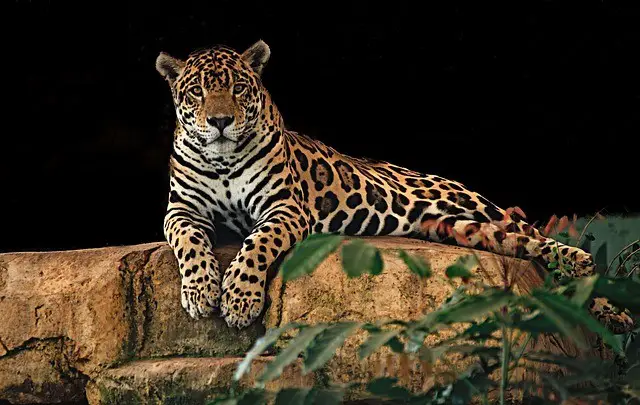
2. Jaguar Scientific Name
- The scientific name of the jaguar is “Panthera onca”.
3. Jaguar Classification – Jaguar Taxonomy
- The following is the Scientific Classification or Taxonomy of jaguar:
| Kingdom | Animalia |
| Phylum | Chordata |
| Sub-phylum | Vertebrata |
| Class | Mammalia |
| Order | Carnivora |
| Sub-order | Feliformia |
| Family | Felidae |
| Sub-family | Pantherinae |
| Genus | Panthera |
| Species | Panthera onca |
4. Jaguar Etymology
- It is believed that the word jaguar is derived from the word “yaguara”.
- Yaguara is a word of the South American language Tupi, which means “beast of prey”.
- This word probably entered into English through the trade language “Tupinamba” of Amazonian, via Portuguese jaguar.
5. Jaguar Evolution
- The evolution of the genus Panthera probably occurred between six and ten million years ago in Asia.
- It is believed that the divergence of the jaguar happened around 1.5 million years ago from a common ancestor of Panthera.
- It may have been entered into the continent of America through the Beringia land bridge during the Early Pleistocene.
- The results of mitochondrial DNA analysis of the jaguar show that the evolution of the species’ ancestry occurred between 280,000 and 510,000 years ago.
- The present-day jaguar is a descendant of “Panthera onca augusta”, which was its immediate ancestor and was bigger than the present-day jaguar.
6. Different Types Of Jaguars – Jaguar Species
- No other species or type of the jaguar exists and it is the only of its kind.
- Formerly, several subspecies of the jaguar have been described. But it was made invalid due to the lack of evidence.
- Currently, the Cat Specialist Group and the assessors of the IUCN Red List for jaguar do not recognize any valid subspecies of the jaguar.
- The species exists in two forms or morphs; the spotted morph and the black morph.
7. Characteristics of Jaguar
- Jaguar is the largest cat indigenous to the continents of North and South America.
- In the world, it is the third-largest cat after the tiger and lion.
- A jaguar is a muscular and compact animal.
- They have a general orange-yellow coat color with rosette-like spots.
- Their normal weight range is from 123 to 212 pounds (53 to 96 kg).
- Of all the big cats, jaguars have the shortest tail and legs.
- They are excellent climbers, crawlers, and swimmers.
- They have extremely powerful jaws, which allow them to bite with a very high force.
8. How Fast Can A Jaguar Run – Jaguar Animal Speed
- The running speed of a jaguar is up to 50 miles per hour (80 km/h).
9. How Long Do Jaguars Live – Jaguar Lifespan – Jaguar Age
How Long Do Jaguars Live In The Wild
- In the wild, jaguars usually live for 12 to 15 years.
How Long Do Jaguars Live In Captivity – Jaguars Lifespan In Captivity
- In captivity, jaguars live for up to 23 years.
10. How Strong Is A Jaguar – Jaguar Strength
- Jaguar strength is incredible.
- Of all the big cats, it has excessive jaw strength and the strongest bites.
- The biting power of a jaguar is 1,300 PSI, which is more than that of a tiger and a lion (1,000 PSI).
- Their bite is strong enough to break the skull and go through the brain.
11. What Does A Jaguar Look Like – Jaguar Appearance
What Color Is A Jaguar
- Jaguars have a general orange-yellow to orange-brown coat color, which also sometimes ranges to orange-brown.
- Jaguars of the forest habitat usually have darker coat color than those living in open areas.
- The abdominal region and underside of the body are white.
- The fur has rose-like markings or rosettes for camouflage.
- Every individual jaguar has a different shape of rosettes, which may include one to several dots.
- On the neck and head region, the spots are solid while at the tail it fuses and makes a band-like pattern.
- Polymorphism (the occurrence of more than one form or morphs in the population of the same species) also exists in jaguars.
- A melanistic form (black morph), which is known as Black Panther, exists but is less common.
- In the South American population, the estimated number of black morph is about 6%.
- The albino individuals among jaguars also occur, which are known as White Panthers. However, they are extremely rare.
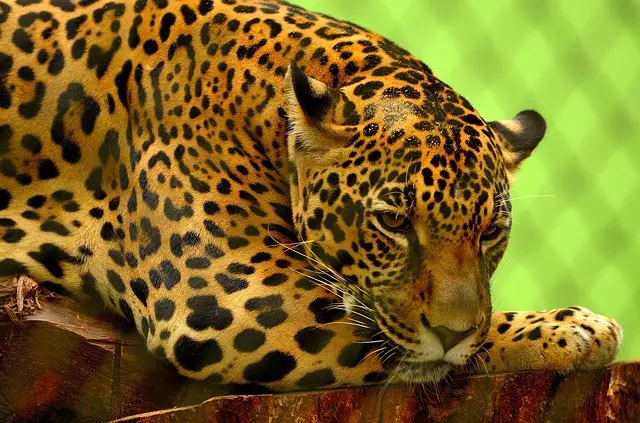
12. How Big Is A Jaguar – Jaguar Size
- The size of a jaguar varies greatly.
- The body length from nose to tail ranges from 3.7 to 6.1 feet (1.12 to 1.85 meters).
- Size variations are also observed across the regions. Jaguars found in North America are relatively smaller than those found in South America.
How Tall Is A Jaguar – Jaguar Height
- At the shoulders, a jaguar is 2 to 2.5 feet (63 to 76 cm) tall.
What Is The Weight Of A Jaguar – Jaguar Weight
- The normal range of a jaguar’s weight is from 123 to 212 pounds (56 to 96 kg).
- The lowest weight is up to 79 pounds (36 kg) of small females.
- The highest recorded weight is about 348 pounds (158 kg) of exceptionally larger males.
13. Where Do Jaguars Live – Jaguar Habitat Facts – What Habitat Do Jaguars Live In
- A large variety of habitats are home to jaguars, including rainforests, deciduous forests, woodlands, grasslands, and swamps.
- They prefer to live in the wet habitats of tropical rainforests and swampy savannas.
- In grasslands and forests, jaguars usually live in small caves, under rock ledges, and in marshlands near lakes or rivers.
- All of the jaguar’s habitats are usually associated with the presence of water.
Where Do Jaguars Live In The Rainforest – Jaguar Rainforest
- Jaguars live in the Amazon rainforest.
- In the rainforest, jaguars are the inhabitants of the Understory Layer.
- Other animal species found in this layer of rainforest are monkeys, lizards, snakes, frogs, and bats.
14. Where Are Jaguars Found – Where Are Jaguars Located
- Jaguars are native creatures to the continents of North and South America.
Jaguar Habitat Range
- The present-day habitat range of the jaguar extends from Mexico (North America) to South America via Central America including most regions of Amazonian Brazil.
- The countries in this range are Argentina, Belize, Columbia, Bolivia, Sarinam, Peru, Ecuador, French Guiana, Guyana, Guatemala, Honduras, Nicaragua, Costa Rica, Panama, Paraguay, Venezuela, and the United States.
- In Belize, jaguars are found in the Cockscomb Basin Wildlife Sanctuary in an area of about 400 km².
- In Mexico, they are found in the Sian Ka’an Biosphere Reserve in a region of up to 5,300 km².
- In Peru, jaguars live in the Manu National Park in an area of about 15,000 km².
- In Brazil, jaguars are found in Xingu National Park in a region of approximately 26,000 km².
15. Jaguar Historic Range
- The historic range of jaguars was far wider than their current range.
- Once they roamed as far north as the states of New Mexico and Arizona (United States) and as far south as the country of Argentina.
- According to a recent scientific evaluation of the IUCN Red List of Threatened Species, the present range of jaguars is only about 51% of their historic range.
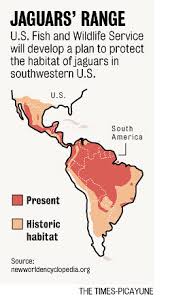
16. Where Do Jaguars Sleep
- Jaguars do rest and sleep usually in trees, long grasses, and an area surrounded by trees.
- They like to remain hidden while resting and sleeping.
17. Jaguar Life Cycle
- The lifecycle of jaguars starts when they become sexually mature.
- Females mature at the age of 2 years while males at the age of 3 to 4 years.
- In the wild, they mate throughout the year.
- The gestation period is 93 to 105 days.
- The cubs are weaned at the age of three months.
- However, they stay in the den where they were born for up to 6 months.
- They remain with their mothers for one to two years until they become capable of establishing their territory.
- Their generation length is up to 9.8 years.
- The estimated lifespan of jaguars in the wild is 12 to 15 years.
- While in captivity they live for about 23 years.
18. What Do Jaguars Eat – What Is A Jaguar’s Diet
- Like all other big cats, the jaguar is an obligate carnivore in nature.
- Obligate carnivores are animals who eat flesh or meat of other animals as a 70% part of their diet.
- Jaguar is an opportunistic hunter and prey to a wide range of animals.
- At least 87 animal species encompass a jaguar’s diet.
- They usually prefer to prey on animals of a weight range from 99 to 187 pounds (45 to 85 kg).
- Capybara and giant anteater are the most common animal species a jaguar prefers to prey and eat.
- After killing prey, jaguars dragged it to a sheltered spot. They usually start eating the neck and chest region first before the midsection.
- At one feed, they can eat up to 25 kg of meat in the wild after a period of famine.
- The estimated daily food requirement of a jaguar is 1.4 kg (3.5 pounds) of meat.
- The recommended daily amount of meat for captive jaguars is more than 2 kg (4.4 pounds).
- There is evidence that jaguars also eat the roots of the Banisteriopsis caapi plant in the wild.
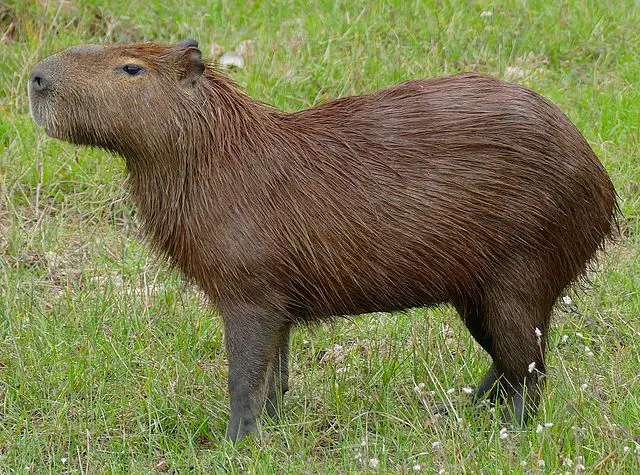
What Do Jaguars Eat In The Rainforest
- Jaguars are the apex predator of the rainforest.
- From fish to anaconda, a jaguar has a wide range of prey in the rainforest.
- Their most common prey includes; capybara, giant anteater, wild boar, common caiman, nine-banded armadillo, collared peccary, and white-nosed coati.
- Sometimes, they also hunt livestock.
19. Jaguar Hunting Prey
- To hunt prey, jaguars usually use the common and typical Panthera technique of deep throat bite and suffocation.
- However, they sometimes also use a unique method of attacking directly on the skull of the prey and piercing the brain.
- This method is particularly employed with reptiles such as caiman and mammals.
- While the sea turtles, such as the huge leatherback sea turtle, are usually attacked on the head and beheaded before eating.
- They do not chase prey but rather stalk and ambush prey.
- They even jump into water after prey when ambushing.
20. Jaguar Ecosystem
- A jaguar is an apex predator and lays on the top of its food chain.
- As a jaguar is the predator of at least 87 animal species, it plays a vital role in the ecosystem by controlling the population of other animal species.
- Their presence in the ecosystem keeps the food chain in balance, which is necessary for a healthy environment.
21. What is A Female Jaguar Called
- There is no specific name for a female jaguar to define her.
- She is just called a “female jaguar”.
22. How Do Jaguars Reproduce – Jaguar Reproduction
- Jaguars reproduce sexually.
- They have the mating season all around the year. However, an increased birth rate is observed if the prey is available in abundance.
- Males recognize the fertile females with the scent marks of their urine and with increased vocalization.
- After mating, the pairs separate and the females bear all the responsibility of parenting.
- The cubs are born after a gestation period of 93 to 105 days.
- Females nurse the cubs for 3 months and protect them in the birth den for up to 6 months.
How Many Babies Do Jaguars Have
- Jaguars have 2 to 4 cubs or babies.
- Most commonly, they have 2 cubs.
23. Baby Jaguar Facts
- The baby jaguars or cubs are born blind and can see after two weeks.
- They are fed by their mother’s milk for up to 3 months.
- They stay in the hidden birth lair for up to 6 months.
- After the age of 6 months, the cubs start joining their mother on the hunt.
- The cubs stay in their mother’s company for 1 to 2 years, until they become able to establish a territory.
What Is A Baby Jaguar Called
- A baby jaguar is called a “Cub”.
24. What Eats A Jaguar – What Are Jaguar’s Predators
- A jaguar is an apex predator and no animal can dare to hunt it.
- Human beings are the only predators of the jaguars.
25. Jaguar Adaptations – Jaguar Adaptations In The Tropical Rainforest:
Jaguar Physical Adaptation
- Some of the physical adaptations of a jaguar include:
- Rosettes’ pattern on the fur provides them camouflage in the dappled light, especially in the tropical rainforest habitat.
- The compact and muscular body makes them extra powerful.
- A large head and powerful jaws through which they can even pierce the skull bones and hard shells of their prey.
- Short legs and padded paw structure allow them to run fast and move silently while following the prey.
Jaguar Head
- Jaguar has a large head with powerful muscular jaws.
- The jaws of a jaguar are so powerful that it can bite with a force of 1,110 Ibf (503.6 kgf) at canine teeth and 1,556 Ibf (705.8 kgf) at the carnassial teeth.
- With such a powerful bite, they can even break the extremely hard shells of turtles and the skull bones of other animals.
Jaguar Paw
- Jaguars have strong and roughly padded paws.
- It provides them extra grip when running and climbing.
- Due to their paw structure, they can move in a silent way near the prey.
Jaguar Claws
- The claws of a jaguar are excellently adapted for tearing the prey.
Jaguar Skin
- The skin of jaguars has fur of orange-yellow to reddish-brown color.
- It has a rosette pattern, which provides them camouflage in the forest habitat.
Jaguar Tail
- The tail of jaguars is the shortest of all the big cats.
- It has 18 to 30 inches (45 to 75 cm) in length.
- The tail provides them balance when walking, running and climbing.
Jaguar Legs
- Jaguars have short, stocky, and powerful legs.
- Their legs are much shorter if compared with the legs of a tiger or lion of the same size and weight.
- Due to shorter legs, jaguars are excellent swimmers and climbers.
- Shorter legs are a special adaptation for a rainforest habitat, where most of their prey is found in trees. There, they also often encounter swamps and prey fish and other animals in the river.
Jaguar Behavioral Adaptations
- The behavioral adaptations of jaguars include:
- They are nocturnal (active at night) in nature. This adaptation provides them a good hunt at night when most of the animals are sleeping and unaware of their arrival. The dusk and dawn are the most active periods for a jaguar, however, they may also be active at other times of the day.
- Jaguars are excellent swimmers. This adaptation allows them to survive in the rainforest habitat. The rainforests are full of flooded and swampy regions, and they also often need cool baths due to the hot climate. Due to their ability of swimming, jaguars can easily hunt fish and other aquatic animals.
- Jaguars are also exceptional climbers. This behavior is also a special adaptation for rainforests where most of the animals are found in trees.
- Jaguars also exhibit a unique behavior of killing the prey at the skull and piercing the brain. Due to this behavior, jaguars are also known as occipital crunchers.
26. Are Jaguars Endangered – Why Are Jaguars Endangered
- Jaguar is listed as a “Near Threatened” species on the IUCN Red List, which means its population is decreasing.
- Jaguars are endangered because:
- They are killed for fur and body parts.
- Farmers kill them to protect their livestock as jaguars are extremely destructive to their cattle.
- Jaguars are also killed for trophy hunting.
- Habitat loss is the largest factor for their endangeredness.
27. How Many Jaguars Are Left In The Wild – Jaguar Population
- The estimated population of jaguars in the wild is up to 15,000 individuals.
- In Mexico, a 20% increase in the population of jaguars has been recorded since 2010.
28. Amazon Rainforest Jaguar Facts
- Jaguars are the well-known apex predators in the Amazon rainforest.
- From the west to the east (from Ecuador to Brazil), they roam everywhere in the Amazon rainforest. The highest population of jaguars is found there.
- For researchers, the Amazon rainforest is the best site to monitor the population of jaguars through camera traps. As jaguars have elusive nature and it often becomes difficult for researchers to check on them.
- Jaguars share the habitat of the Amazon rainforest with pumas. Both the big cats have almost similar behavior. However, the use of different areas at different intervals of the day minimizes their interaction.
- Jaguars have special adaptations to survive in the hot and wet climate of the Amazon rainforest. They are excellent swimmers and climbers as the Amazon rainforest is full of flooded areas and waterways.
- From small fish to caiman crocodiles, and from birds to large mammals, jaguars hunt a wide range of prey in the Amazon rainforest.
- Jaguars have a special place and importance in the cultures of many Amazon rainforest native tribes. They respect jaguars for their power and often feature it in their tribal stories, songs, and dances.
29. What Is The Difference Between A Jaguar And A Panther
- The following are the differences between a jaguar and a panther:
| Jaguar | Panther |
| Felid species of genus Panther | Genus (not species) of big cats. Any big cat is denoted as a panther |
| Indigenous to the North and South American continents. Mostly found in rainforests | Found about throughout the world in many habitats |
| Have rosette spotted pattern. Melanistic individuals of dark balkish color are found. White albinos are also very rarely found | Varies greatly in color patterns and appearance |
| Jaguar is included in the four species of big cats that roar | Only a few panther species roars, not all |
| Show a unique hunting method of killing the prey by breaking the skull and piercing the brain | Most panthers usually kill the prey through suffocation and throat bite |
30. What Is The Difference Between A Jaguar And A Leopard
- The following are some of the differences between a jaguar and a leopard:
| Jaguar | Leopard |
| Indigenous to the continents of North and South America | Found all-over most of Asia and Africa |
| Have a large, heavier, and more powerful body | Smallest of all the big cat species, less heavy and powerful than a jaguar |
| Have large head and short muscular limbs | The head of a leopard is relatively small than of a jaguar while its limbs are also long and less muscular than of a jaguar |
| The rosettes on the fur are large, darker, and fewer in number with spots inside | The rosettes on the fur are relatively small, many, and with no spots in the middle |
| Kill the prey through suffocation and throat bite as well as through a unique technique of breaking the skull and piercing the brain | Kill the prey through suffocation and throat bite |
| Good swimmer and loves water | Good swimmer but usually avoid water |
| Not aggressive towards people | Very aggressive towards people |
31. What Is The Difference Between A Cheetah And A Jaguar
- The following are some of the differences between a Cheetah and a jaguar:
| Jaguar | Cheetah |
| Indigenous to North and South America | Found in South, North, and East Africa and some regions of Iran |
| Have a rosette pattern on the coat with spots in the middle | Have simple black spots on the coat. Have black stripes on the face running down from the eyes like tear marks |
| Have big, compact, and heavier body, short tail and legs, and a large head and powerful jaws | Have a long muscular body, long legs and tail, and a small head |
| Can run at the maximum speed of 80 km/hour | The fastest big cat and can run with a maximum speed of 112 km/hour |
| Good swimmer and love water | Can swim but avoid water |
| Jaguars roar | Cheetahs don’t roar |
32. Jaguar Fun Facts For Kids – Interesting Facts About Jaguars
- The shape of the rosette pattern on the jaguar’s skin is different and unique for every individual.
- If got the opportunity, a jaguar kills its prey through the top of the skull with a single bite and pierces the brain with fangs. Due to his ability, jaguars are also called “occipital crunchers”.
- Felid researchers and native people consider the ambushing abilities of jaguars incomparable in the animal kingdom.
- The vision of jaguars at night is six times sharper than that of humans.
- To lure fish, a jaguar usually dips its tail in water just like a fishing line.
- Jaguar is featured as a symbol of strength in the mythologies of many ancient Mesoamerican cultures such as Aztec and Maya.

